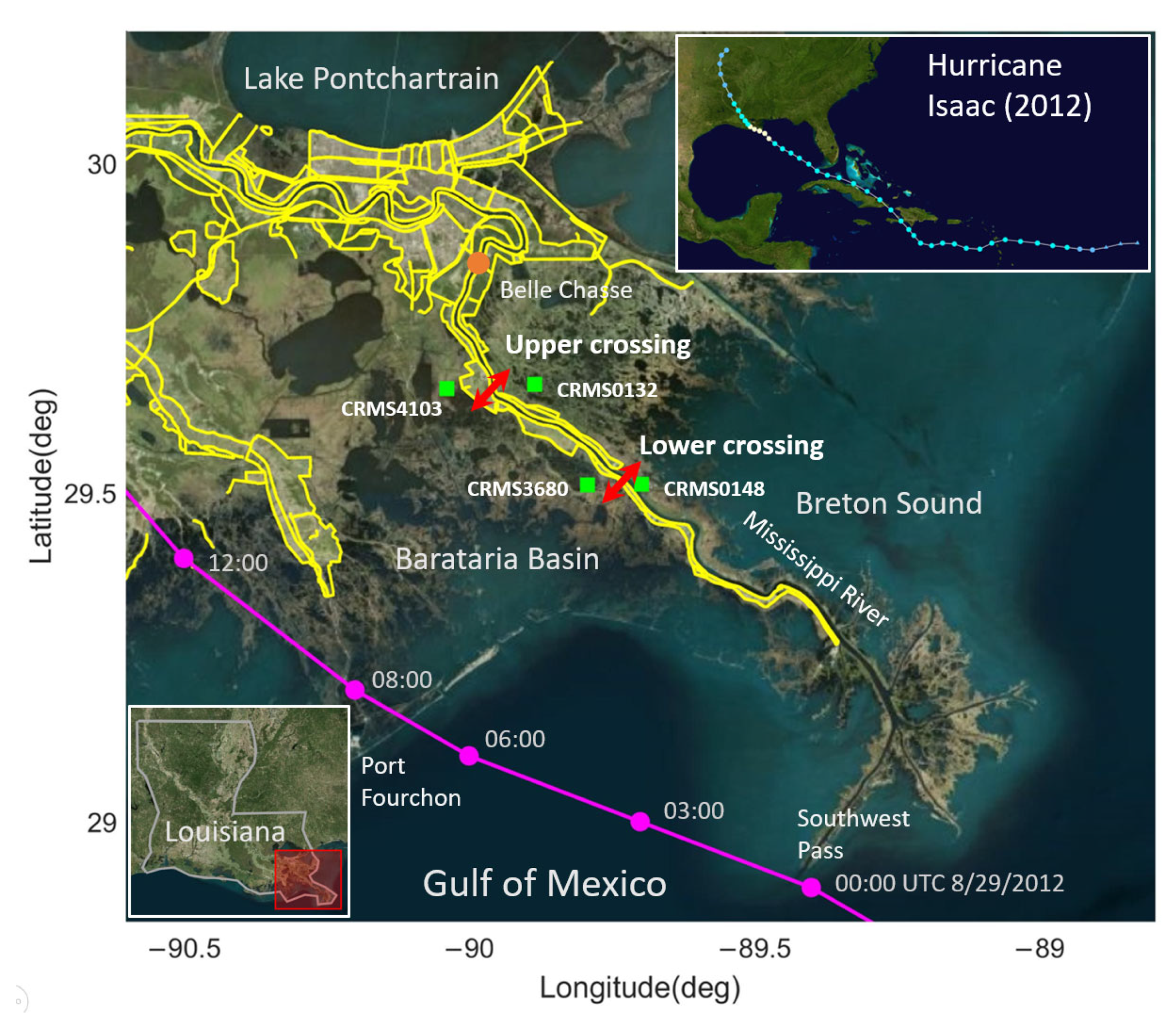The Impact of Levee Openings on Storm Surge: A Numerical Analysis in Coastal Louisiana
Abstract
:1. Introduction
2. Storm Surge Model
2.1. Delft3D-FLOW
- where= total water depth, h = bathymetric depth, = water levelU, V = depth-averaged velocities in x-, y- directionsQ = contributions per unit area due to the discharge or withdrawal of water, precipitation and evaporation
- wheref = Coriolis parameterg = acceleration due to gravity= reference density of waterP = atmospheric pressure at the sea surface= surface wind stresses in x-, y- directions= bottom friction stresses in x-, y- directions= momentum dispersions in x-, y- directions= contributions due to external sources or sinks of momentum (e.g., external forces by hydraulic structures, discharge or withdrawal of water) in x-, y- directions
2.2. Model Setup
3. Model Results and Flux Analysis
3.1. Hurricane Isaac (2012)
3.2. Storm Surge Results
3.3. Flux Analysis
4. Conclusions
Author Contributions
Funding
Institutional Review Board Statement
Informed Consent Statement
Data Availability Statement
Acknowledgments
Conflicts of Interest
References
- U.S. Army Corps of Engineers (USACE). Mississippi River and Tributaries Project; Mississippi Valley Division: Vicksburg, MS, USA, 2019.
- Hu, K.; Chen, Q.; Wang, H. A numerical study of vegetation impact on reducing storm surge by wetlands in a semi-enclosed estuary. Coast. Eng. 2015, 95, 66–76. [Google Scholar] [CrossRef]
- U.S. Army Corps of Engineers (USACE). Louisiana Coastal Protection and Restoration (LACPR). Final Technical Report; New Orleans District, Mississippi Valley Division: Vicksburg, MS, USA, 2009.
- Coastal Protection and Restoration Authority of Louisiana (CPRA). Louisiana’s Comprehensive Master Plan for a Sustainable Coast; CPRA: Baton Rouge, LA, USA, 2012.
- Hu, K.; Ding, P.; Wang, Z.; Yang, S. A 2D/3D hydrodynamic and sediment transport model for the Yangtze Estuary, China. J. Mar. Syst. 2009, 77, 114–136. [Google Scholar] [CrossRef]
- Vousdoukas, M.I.; Voukouvalas, E.; Annunziato, A.; Giardino, A.; Feyen, L. Projections of extreme storm surge levels along Europe. Clim. Dyn. 2016, 47, 3171–3190. [Google Scholar] [CrossRef] [Green Version]
- Veeramony, J.; Condon, A.; van Ormondt, A. Forecasting storm surge and inundation: Model validation. Weather. Forecast. 2017, 32, 2045–2063. [Google Scholar] [CrossRef]
- Hu, K.; Chen, Q.; Wang, H.; Hartig, E.K.; Orton, P.M. Numerical modeling of salt marsh morphological change induced by Hurricane Sandy. Coast. Eng. 2018, 132, 63–81. [Google Scholar] [CrossRef]
- Silveira, F.; Lopes, C.L.; Pinheiro, J.P.; Pereira, H.; Dias, J.M. Coastal floods induced by mean sea level rise—Ecological and socioeconomic impacts on a mesotidal lagoon. J. Mar. Sci. Eng. 2021, 9, 1430. [Google Scholar] [CrossRef]
- Zhu, Q.; Wiberg, P.L. The importance of storm surge for sediment delivery to microtidal marshes. J. Geophys. Res. Earth. Surf. 2022, 127, e2022JF006612. [Google Scholar] [CrossRef]
- Chow, A.C.H.; Sun, J. Combining Sea level rise inundation impacts, tidal flooding and extreme wind events along the Abu Dhabi coastline. Hydrology 2022, 9, 143. [Google Scholar] [CrossRef]
- Deltares. Delft3D-FLOW User Manual (Version 4.05). 2022. Available online: https://content.oss.deltares.nl/delft3d4/manuals/Delft3D-FLOW_User_Manual.pdf (accessed on 23 October 2022).
- Hu, K.; Chen, Q.; Kimball, K.S. Consistency in hurricane surface wind forecasting: An improved parametric model. Nat. Hazards 2012, 61, 1029–1050. [Google Scholar] [CrossRef]
- Berg, R. Hurricane Isaac (AL092012) 21 August–1 September 2012. Tropical Cycle Report; NOAA National Hurricane Center: Miami, FL, USA, 2013. Available online: http://www.nhc.noaa.gov/data/tcr/AL092012_Isaac.pdf (accessed on 23 October 2022).











Publisher’s Note: MDPI stays neutral with regard to jurisdictional claims in published maps and institutional affiliations. |
© 2022 by the authors. Licensee MDPI, Basel, Switzerland. This article is an open access article distributed under the terms and conditions of the Creative Commons Attribution (CC BY) license (https://creativecommons.org/licenses/by/4.0/).
Share and Cite
Hu, K.; Meselhe, E.; Rhode, R.; Snider, N.; Renfro, A. The Impact of Levee Openings on Storm Surge: A Numerical Analysis in Coastal Louisiana. Appl. Sci. 2022, 12, 10884. https://doi.org/10.3390/app122110884
Hu K, Meselhe E, Rhode R, Snider N, Renfro A. The Impact of Levee Openings on Storm Surge: A Numerical Analysis in Coastal Louisiana. Applied Sciences. 2022; 12(21):10884. https://doi.org/10.3390/app122110884
Chicago/Turabian StyleHu, Kelin, Ehab Meselhe, Rachel Rhode, Natalie Snider, and Alisha Renfro. 2022. "The Impact of Levee Openings on Storm Surge: A Numerical Analysis in Coastal Louisiana" Applied Sciences 12, no. 21: 10884. https://doi.org/10.3390/app122110884
APA StyleHu, K., Meselhe, E., Rhode, R., Snider, N., & Renfro, A. (2022). The Impact of Levee Openings on Storm Surge: A Numerical Analysis in Coastal Louisiana. Applied Sciences, 12(21), 10884. https://doi.org/10.3390/app122110884






